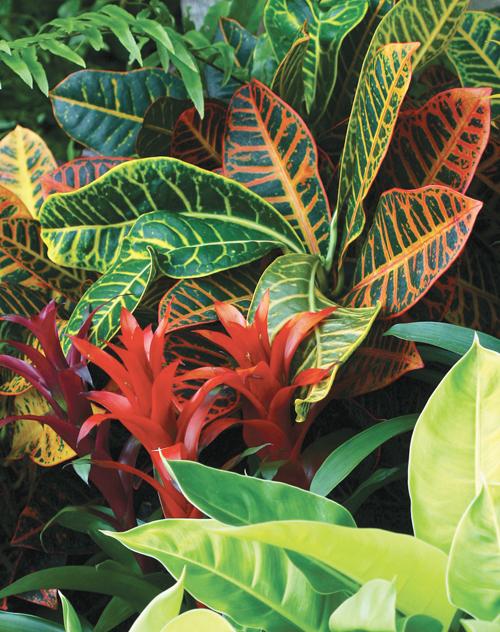Phuket Gardening: The ‘who’s hue’ of ornamental leaves

PHUKET: Foliage plants, as we noted last week, are cultivated mainly for their ornamental leaves. But such a bald statement requires qualification. After all, many flowering plants also have attractive foliage, and this is especially true in the tropics where the tendency is for most leaves to be evergreen and glossy. Nor am I thinking of foliage plants, which originate in the forest understorey, and which feature primarily as tropical container plants – both outdoor or indoor.
Indeed, if these are to be effective in open gardens, they will need not only regular irrigation, but a carefully chosen position in filtered or deep shade.
Such plants – aglaonemas, dieffenbachias, anthuriums, philodendrons, the whole family of ferns, are not my concern today. They have been given plenty of space elsewhere.
Rather, I am talking about foliage plants that can and do grow cheek by jowl with flowering shrubs, plants that can provide a backdrop to rioting blossom, and can add a contrasting range of interesting textures and shapes to flower beds. In the case of variegated or multi-hued foliage plants, they will also add year-round color, particularly when other flowering shrubs are on strike.
It was for this reason that I opened the account last time around with acalypha wilkesiana, with its splendidly multicolored leaves. Though it is related to A hispida (the chenille plant), with its long tassels of red blooms, wilkesiana is grown entirely for its foliage. Combinations include bronzy green mottled with red and purple, yellow and green edged with purple, stippled red and orange.
So colorful are the masses of crinkly leaves that acalypha will outdo many flowering shrubs.
Jacob’s Coat or copper leaf is, moreover, shrubby and compact, and will certainly survive in full sun. Indeed, when established, it may reach five or six feet and will provide a certain amount of shelter for smaller plants. It is amenable to clipping, and Thais often use it as a hedge or low barrier. A newish variety, with mostly deep crimson and bronze leaves, is proving popular. It is fairly tolerant of dry conditions.
Another Thai favorite, though totally different in appearance from Jacob’s coat, is cordyline terminalis. Often referred to as the croton, its large, glossy leaves sprout from a single erect stem. Leathery and deeply veined, they come in a remarkable spectrum of colors. Like most variegated plants, this one probably began life as an all-green form and only gradually developed the huge range of variations we see today.
There are many leaf shapes, varying from long, narrow, lance-shaped ones as in the varieties “Stoplight” and “Yellow Johanna Coppinger” to the larger ovate foliage of the orange and red “Chief”, or the widely grown green and yellow “Stewartii”. Some have smooth margins, others have lobed edges. It is not hard to see why this plant was a sensation when it first arrived in Western drawing rooms; nowadays, however, it is grown in the tropics mainly as a spectacular garden plant where it can achieve the dimensions of a small tree.
It looks particularly effective in group plantings, or as a backdrop to a border with smaller plants in front. While the croton approves of well-drained soil and plenty of sun, it will soon show its displeasure by drooping its leaves if it lacks adequate water.
Prolonged drought will cause the lower ones to drop off, giving the plant a rather gaunt appearance. And it will need feeding. It will certainly grace a container outdoors, and with regular watering and feeding will grow to a height of several feet.
Despite its earlier popularity as a house plant, the codiaeum does not enjoy air-conditioning and deep shade. Better in the open air.
Tip of the week – Garden pests: Caterpillars
Unlike many pests, caterpillars are normally visible. The larvae or grubs of butterflies, moths and some beetles, they feed voraciously on chosen plants.
Normally they hide under the foliage and consume the leaves from below, but they will also attack young shoots. Their attacks, rarely terminal, are nonetheless disfiguring, and it may take plants time to recover.
Caterpillars are especially common in gardens because adult insects can find a range of host plants on which to lay their eggs.
The dilemma? Do you kill them, or put up with their ravages, knowing that attractive butterflies and moths will later populate your patch?
Personally, I try to keep them, especially ones which will turn into hawk moths or varieties of monarch butterflies.
Shrubs of the apocynaceae genus are favorite targets. Also Indian milkweed. Do not handle hairy caterpillars. They can produce a nasty skin rash. Instead, cut off the affected shoot.If you have a question or a garden that you would like featured, you can email the author here.
Keep checking our online Phuket Lifestyle pages or join our Facebook fan page for regular gardening features and tips.
— Patrick Campbell
Latest Thailand News
Follow The Thaiger on Google News:


























